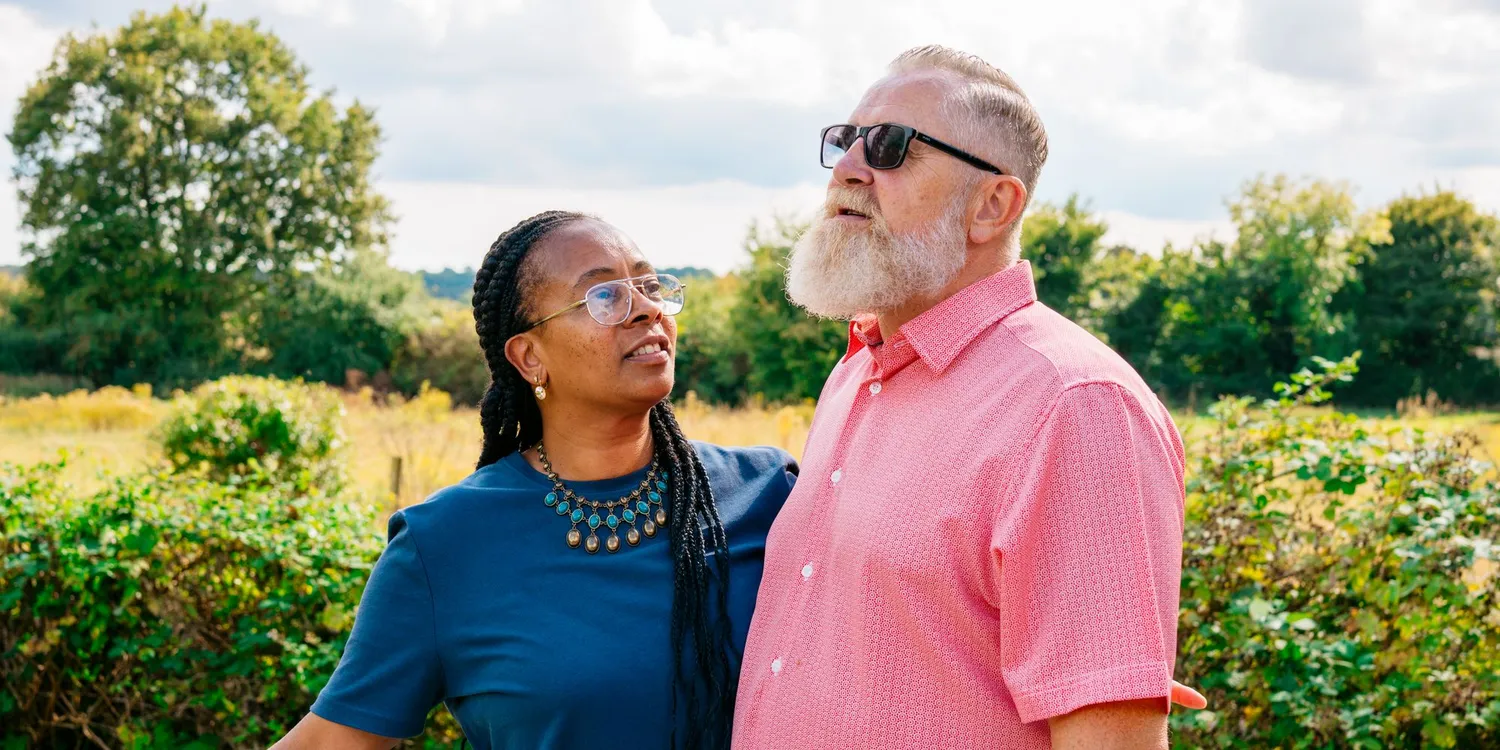21 Oct 2024
This article has been reviewed by Lester Morse, Director of Rehabs UK, who has over 30 years’ experience helping individuals overcome various forms of addiction. Rehabs UK is a leading authority in addiction treatment and recovery and offers a range of connected services and support including detox and rehabilitation programmes as well as therapy.
Interventions are important for those who are deep into addiction, they provide a supportive environment to help get the individual to accept their addiction and seek help. 80-90% of interventions are successful and are often recommended by addiction specialists for almost anyone dealing with addiction.
This article aims to break down and compare different intervention models and will explain what an addiction intervention is and how they work. It will also breakdown commonly used intervention models such as The Johnston Model and the Systemic family model.
[Contents]
What is an addiction intervention?
How does an intervention work?
Intervention strategies and methods
Get support for staging an intervention
What is an addiction intervention?
An addiction intervention is a meeting involving an individual who may be suffering from addiction, their loved ones and sometimes a professional. The aim is to try to get the individual to recognize and accept the addiction and encourage them to look for treatment.
For the intervention to be successful it has to be well thought out and carefully planned. Scott Ardley, Senior Treatment Advisor explains “Addiction interventions are always beneficial in some way but you need to go into that conversation in a caring manner with realistic solutions and treatment methods.”
The aim of an addiction intervention is to come up with a plan moving forward, this could include:
How common are interventions?
Interventions are becoming more common as the understanding of addiction as a medical and psychological condition grows. Public awareness campaigns and media coverage have helped in removing some of the stigma attached to seeking help. For example, one of the most well-known drug education campaigns in the UK, "Talk to Frank" was launched in 2003 by the Department of Health and the Home Office. It aims to provide young people, parents, and carers with factual information about drugs and drug use, emphasising the importance of open conversation.
However, the overall number of formal interventions remains relatively low compared to the total population in need of help. Many people still face barriers like stigma, fear, and lack of awareness when it comes to addiction treatment. The Forward Trust reveals that 45% of UK adults aged 18-75 have either directly experienced addiction themselves with a dependency to alcohol, drugs, medication, gambling or sex themselves, or know someone close to them that has. Despite this being equivalent to 22 million UK adults aged 18-75, the stigma that surrounds the condition is stopping or making it difficult for half of those experiencing their own or other people’s addictions from speaking out, with negative judgement (46%) and shame (39%) ruled as top concerns.
How long do interventions last?
This varies depending on the individual's situations and the method of intervention used, however, generally they would follow this timeline:
- Planning and preparation - several days - weeks
- The intervention meetings - 30 minutes - 2 hours
- Immediate follow-up - hours to days
- Post-intervention support - weeks - months
Should interventions be repeated?
If an intervention is unsuccessful it can be repeated to help the person understand the seriousness of their situation over time. However, if there has been a relapse or the individual's circumstances have changed, for example, legal issues, health changes or loss of employment, it may be worth changing the tone to ensure the process remains supportive.
Although there are no clear statistics around what percentage of interventions are repeated, nearly half of the people undergoing support for substance misuse, particularly for opiates, reported being in contact with services multiple times, which suggests that repeat interventions can be important to maintain recovery over time.
When to avoid repeating an intervention?
If the person is feeling alienated. For example, if the individual feels manipulated or becomes hostile and withdrawn after the initial intervention, a second attempt may push the person further away from help.
If there is family burnout. For example, if family or loved ones are emotionally exhausted or feeling overwhelmed by the situation, it might be best to get a professional in to help with the situation before attempting another intervention.
When is an intervention necessary?
A person may require an intervention if they experience:
- A deterioration in their physical or mental well-being
- Encounter legal problems
- Face strained relationships or friendships
- Lose their job as a result of addiction.
In situations where a person is harming themselves or those close to them due to addiction, but is unwilling to acknowledge the problem or get assistance, an intervention becomes essential. Similarly, if attempts at discussing the addiction casually have not worked, a formal intervention might be necessary.
How does an intervention work?
What happens during an intervention?
When an intervention takes place, the concerned individuals come together to express their concerns to the person they are worried about in a non-judgemental manner. Each person will share how the addiction has affected them.
A typical intervention may follow this process:
Pre intervention
- Planning - Making sure the intervention is well thought out by setting clear goals to avoid surprises and increase the chance of being successful.
- Forming a Team - put together a group of people who have concerns and love the individual.
- Gathering information - this should be about understanding the addiction. Research as much as possible about how it can have an effect and solutions.
- Writing impact statements - Each person involved needs to write their own statements on how the individual has impacted their life. This should be empathetic and sincere from a loved one's perspective.
- Rehearsing the intervention - This allows for the real intervention to run more smoothly.
- Setting the scene - Choose a location which is private and doesn’t have many distractions.
The intervention
- Conducting the intervention - this is where you and the team of people can express your concerns and emotions about the individual's addiction. This can be quite emotional but it is important to stay calm.
- Offering help and support - Be supportive. Don’t make false promises and try to lay out a treatment plan which doesn’t overwhelm the individual but makes it look like you have researched and are going to be there along this recovery journey with the individual.
Post intervention
- Getting them to rehab - If the intervention has been successful the next step is to get the individual into rehab. You want to pick a rehab which has a good reputation and is trustworthy. Most rehabs offer 24/7 care and treatments such as therapy.
Scott Ardley, Senior Treatment Advisor states: “We are on hand with anyone who needs help or advice to set up an intervention. Most of the time individuals with an addiction need an extra push to get treatment. Sometimes the individual isn’t ready to accept the help so this can often go on for an extended period of time but eventually, most individuals will accept the help.”
How effective are interventions?
An NLM study looking at trends and challenges of treating depression suggests that the success rate of an intervention is 70-90% in getting the individual to agree to the treatment.
It Is key to highlight that the intervention is just the first step in recovery and will require a lot more work and support to become fully successful. It relies heavily on how willing the individual is to receive and accept help. The potential next steps would be to get a free assessment by a Treatment Advisor who can help assess the treatment needed this could be residential rehab or detox.
Intervention strategies and methods
There are many different types of interventions and what is best suited to the individual will depend on the specific situation. The interventions mentioned within this article include:
- The Johnson model due to it being one of the most popular and effective methods.
- One-to-one interventions can be useful for individuals who can get easily overwhelmed.
- The systemic family model which may be useful if there is often conflict within the family.
- The ARISE model which is a more gradual approach rather than a surprise for the individual and finally the crisis intervention which may be needed in an emergency.
Classic intervention AKA the Johnson model of intervention
One of the most common and well-known methods of intervention is the Johnson model, created by Dr. Vernon Johnson in the 1960s. Dr Johnson was an Episcopal priest and recovering alcoholic who became a prominent figure in the treatment of addiction. His model focuses less on the individual ‘hitting rock bottom’ but looking at other factors as well to seek addiction treatment. The model became popular in America in the late 1970’s and early 80’s with recognition amongst AA groups, 12-step programmes and rehabilitation programmes.
This approach includes a lot of in-depth and careful planning as well as a direct confrontation, which is often with the help of a professional interventionist.
7 Components of the Johnson Method
- Team Formation: Gathering a group of people who care about the individual.
- Planning: Developing a clear and structured plan for the intervention.
- Information Gathering: Collecting facts about the individual’s addiction and its impact.
- Rehearsal: Practising the intervention to ensure smooth execution.
- The Intervention Meeting: Confronting the individual with love and concern.
- Presentation of Treatment Options: Offering a clear treatment plan.
- Follow-Up: Ensuring the individual follows through with the treatment plan.
The success of the model depends on certain factors such as the skill of the interventionist, the readiness of the individual with the addiction and the support of family and friends around them.
Pros and cons of the Johnson method
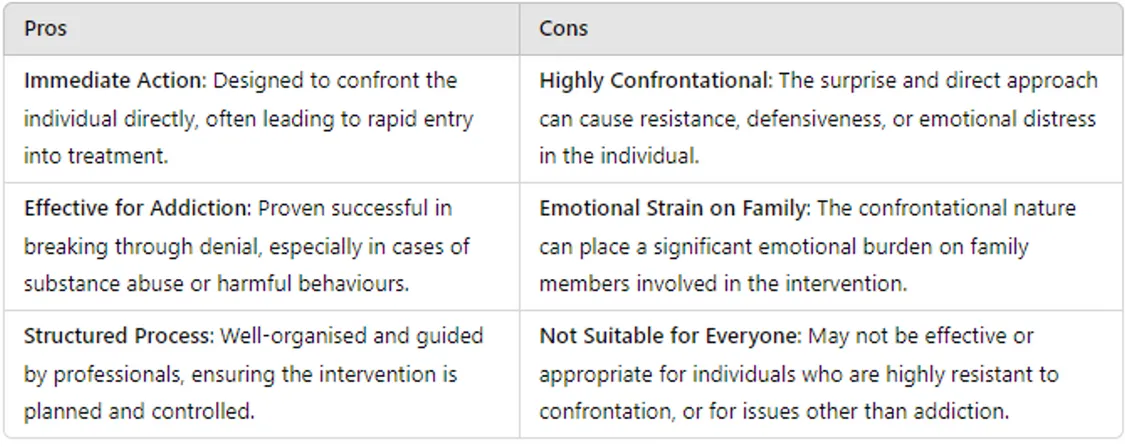
One-to-one intervention model
One-to-one intervention is self-explanatory. One person, usually a close friend or family member will meet up with the individual in a supportive setting to discuss their addiction. This can be a good method for someone who may be overwhelmed in a group setting or prefers a more personal approach.
The One-to-One Intervention Model has its roots in the development of individual psychotherapy and counselling practices that emerged in the early 20th century. Influenced by pioneers like Sigmund Freud (psychoanalysis), Carl Rogers (client-centred therapy), and Aaron Beck (cognitive behavioural therapy), the model grew out of the desire to address individual mental health needs in a focused, personal manner.
It is the dominant model for individual mental health care and is used across many disciplines, including psychology, psychiatry, social work, and coaching. One-to-one interventions are the default method for addressing personal, emotional, and behavioural issues when confidentiality, focused attention, and a personalised approach are crucial.
Aside from this model being one-to-one it differs from the Johnson model because it might be more informal and without the use of a professional. Rehabs UK would always advise seeking a professional opinion on whether there needs to be a professional involved or not. This is due to each situation being different and requiring differing levels of support.
Key differences: one-to-one and Johnson model
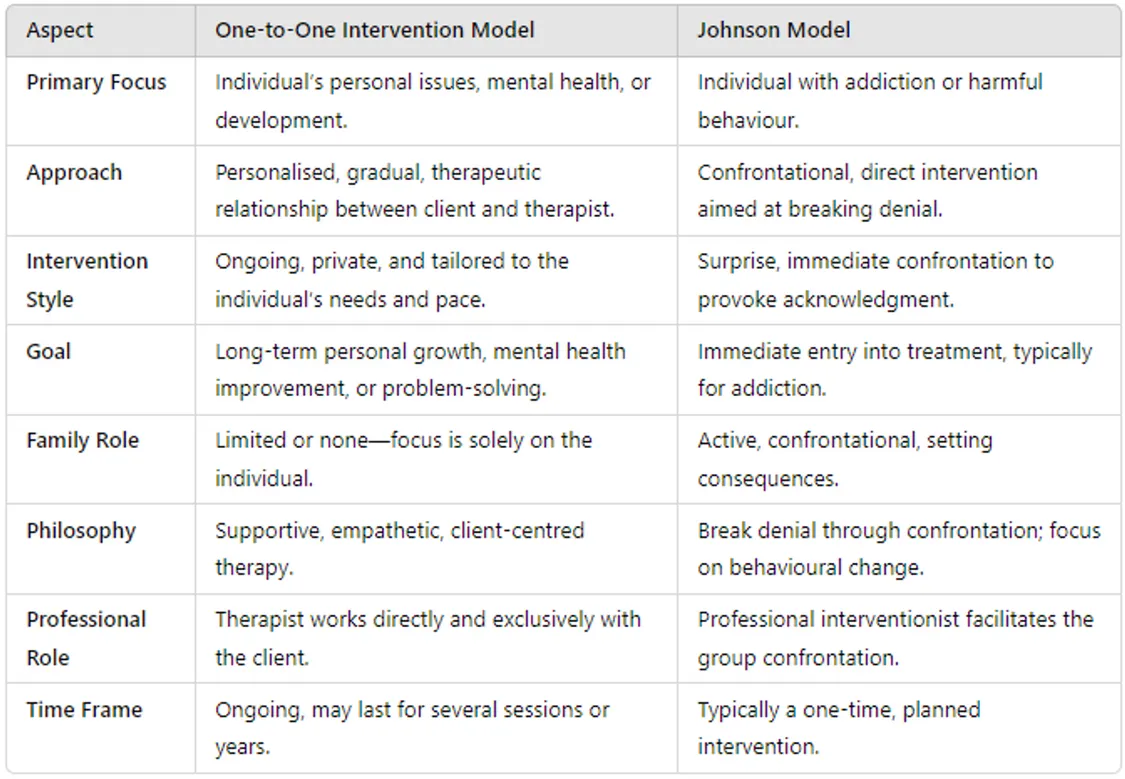
Pros and cons of on-to-one intervention
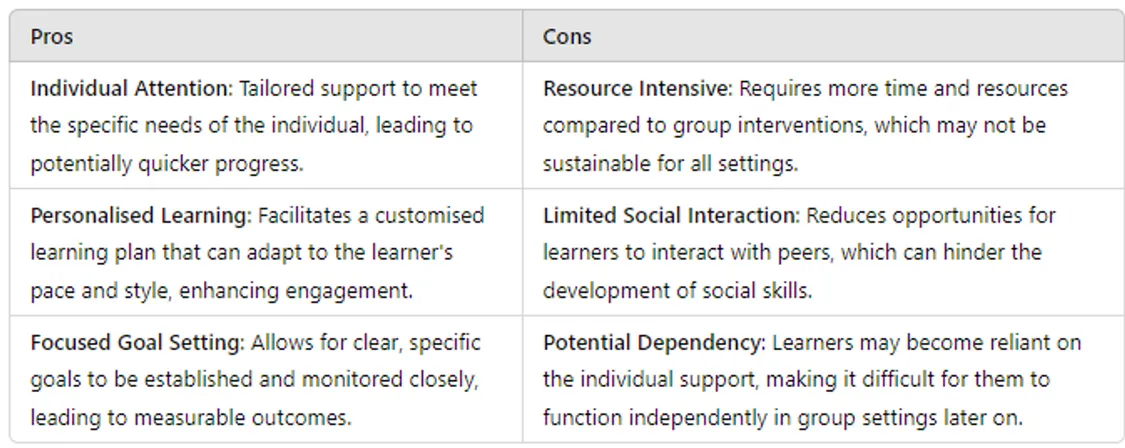
Systemic family model
This model looks more at the family dynamics that might be affected by the addiction. It will involve the whole family in the process and is less about the individual but the whole family dynamic and how this can promote healing and support in the family unit as a whole.
The Systemic Family Model originated from the Milan School of Family Therapy in the late 1970s, heavily influenced by systems theory and the works of Gregory Bateson and others. Systems theory views individuals not in isolation but as part of interconnected systems, with the family being a primary system that shapes behaviours and relationships. Pioneers like Salvador Minuchin, Murray Bowen, and Virginia Satir contributed to the development of family therapy by exploring how family dynamics affect individual behaviour.
The Milan group, particularly Mara Selvini Palazzoli, Gianfranco Cecchin, Luigi Boscolo, and Giuliana Prata, developed this model with the view that families are self-regulating systems, constantly interacting to maintain balance, even if it sometimes perpetuates dysfunctional patterns.
The Systemic Family Model is widely used in family therapy today, especially in contexts like marriage counselling, child therapy, and treatment for issues such as addiction, mental health disorders, or behavioural problems.
The model is commonly used in family therapy because it focuses on understanding and altering the dynamics within the family system rather than viewing problems as belonging to just one person. It's particularly effective for treating intergenerational issues, improving communication, and resolving conflicts within families.
Key Differences: Systemic Family Model and Johnson Model compared
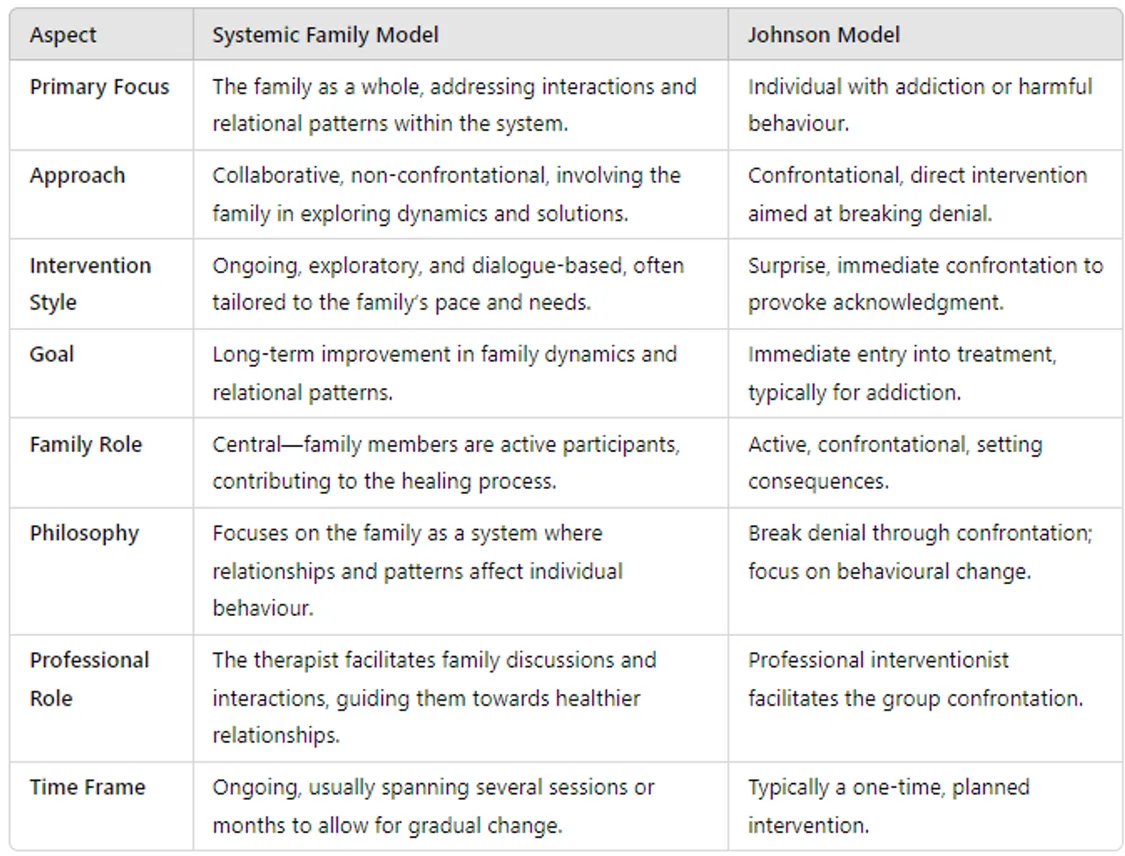
Pros and cons of the Systematic Family Model:
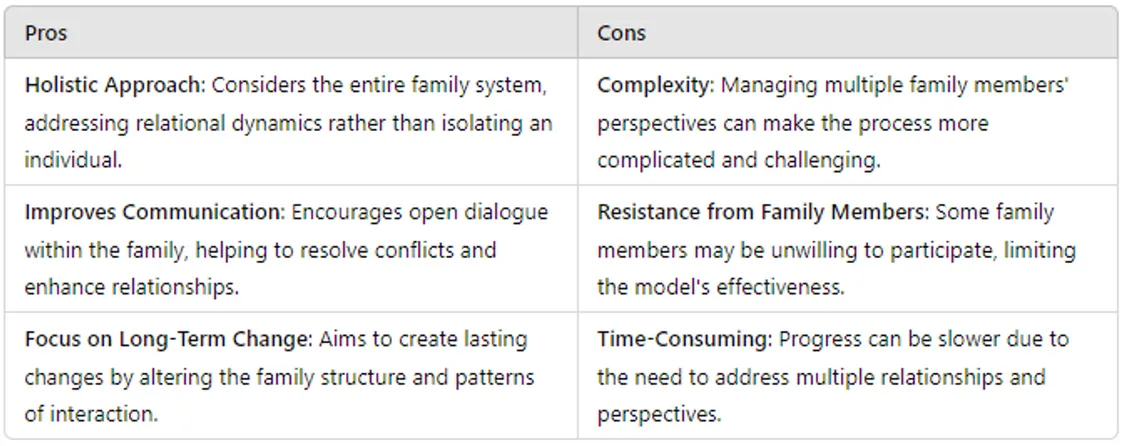
ARISE model of intervention
This is a gradual model which centres around building trust and creating a collaborative effort toward recovery. It involves the family in a series of steps. These steps are each designed to encourage the individual to accept help and treatment.
The acronym ARISE typically stands for:
- A – Awareness: Raising awareness about health disparities and challenges within a community.
- R – Research: Conducting participatory research with the community to identify health concerns and priorities.
- I – Intervention: Co-developing interventions with the community to address these concerns.
- S – Sustainability: Ensuring the interventions are sustainable and continue to benefit the community.
- E – Empowerment: Empowering community members through knowledge, resources, and skills to advocate for their own health.
The framework emphasises equitable partnership, meaning that researchers and community members share power and decision-making throughout the research and intervention process.
The ARISE model has been applied in various health programs addressing issues such as HIV/AIDS prevention, mental health, chronic disease management, and substance abuse. Its strength lies in its ability to mobilise communities by focusing on culturally relevant solutions, ensuring the interventions are both appropriate and effective for the target population.
Key Differences: ARISE Model and Johnson Model compared
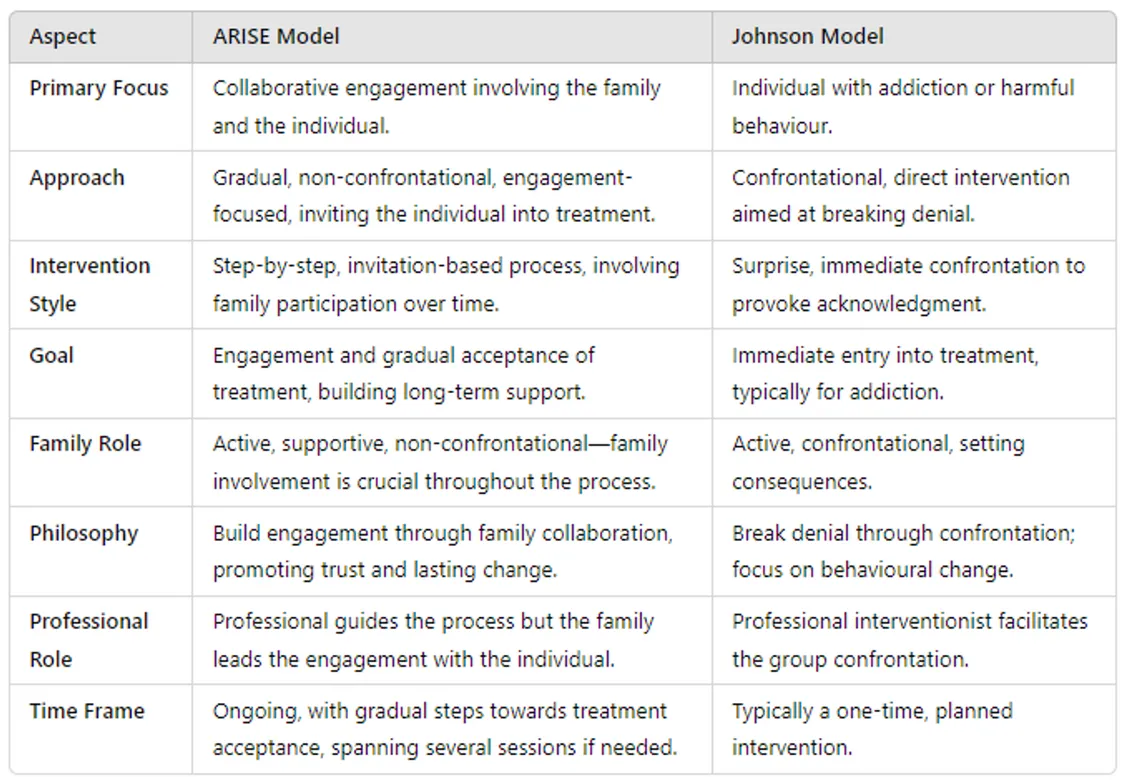
Pros and cons of the ARISE model
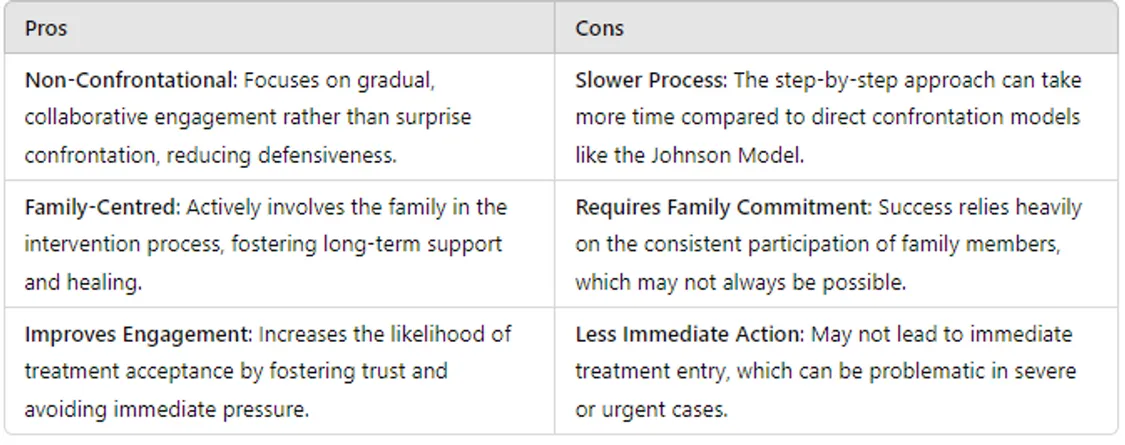
Crisis intervention
This is the method when the issues that are appearing pose a serious risk to their safety or the safety of others. It's often urgent and in some cases, involuntary measures have to take place to make sure the individual receives the help they need as quickly as possible.
For example, if an individual's using is causing them to get violent to themselves or others then a crisis intervention could be the most successful method. This is because it might be a last resort. It differs from a planned out intervention as it is in the event of a crisis and uses specialist crisis teams where needed.
A family would put this together by gathering together important loved ones. In these cases, the fewer people involved the better. The number of participants should be small, usually three to six people, to avoid overwhelming the individual in crisis, unlike other models which ask for multiple loved ones to be involved in the process. The intervention can be done without a professional, however, for a better success rate having a professional there could be beneficial. According to the National Council on Alcoholism and Drug Dependence (NCADD), interventions involving a professional boast a success rate of over 90% in getting the individual to agree to seek treatment whereas a study in the Journal of Clinical Psychology reported that family-led interventions without professional support had modest success rates, often hindered by emotional confrontations and lack of clear treatment pathways.
How Does the Process Differ from Other Models?
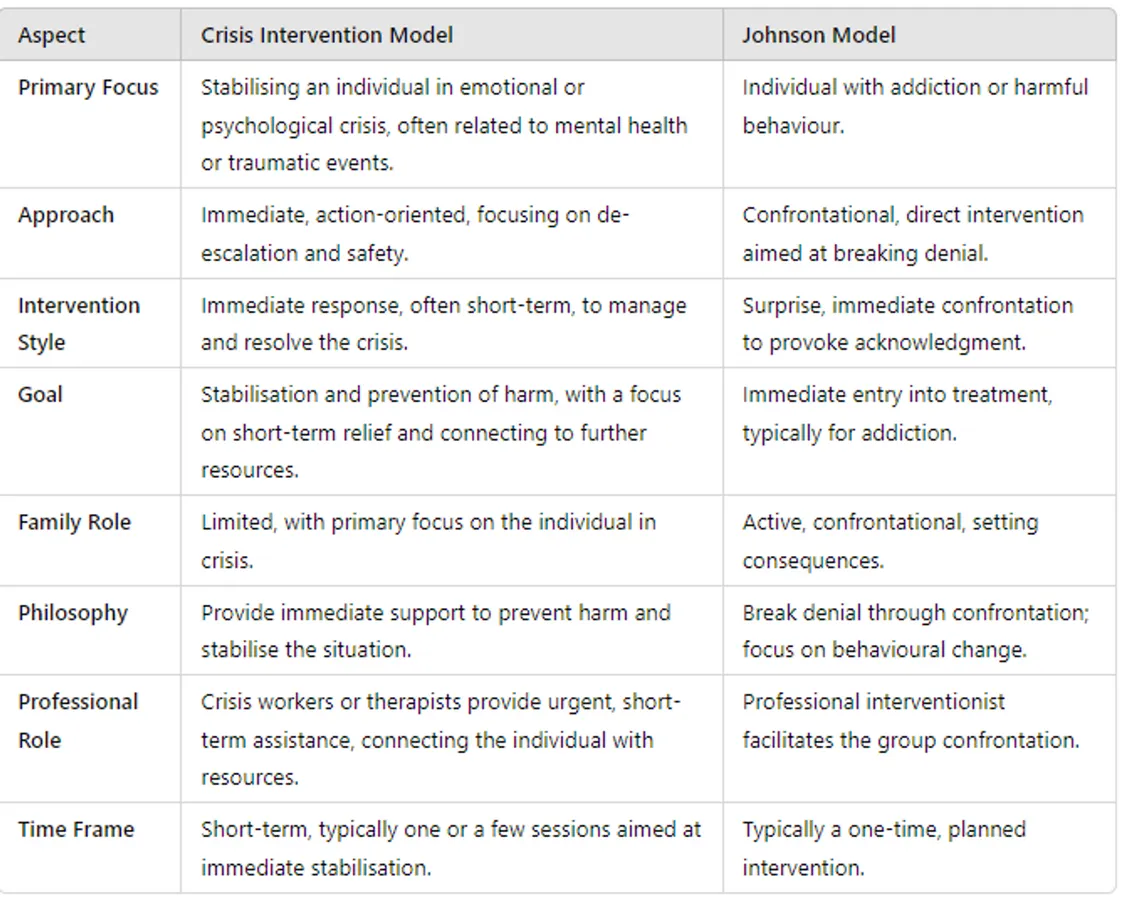
Pros and cons of the Crisis Model
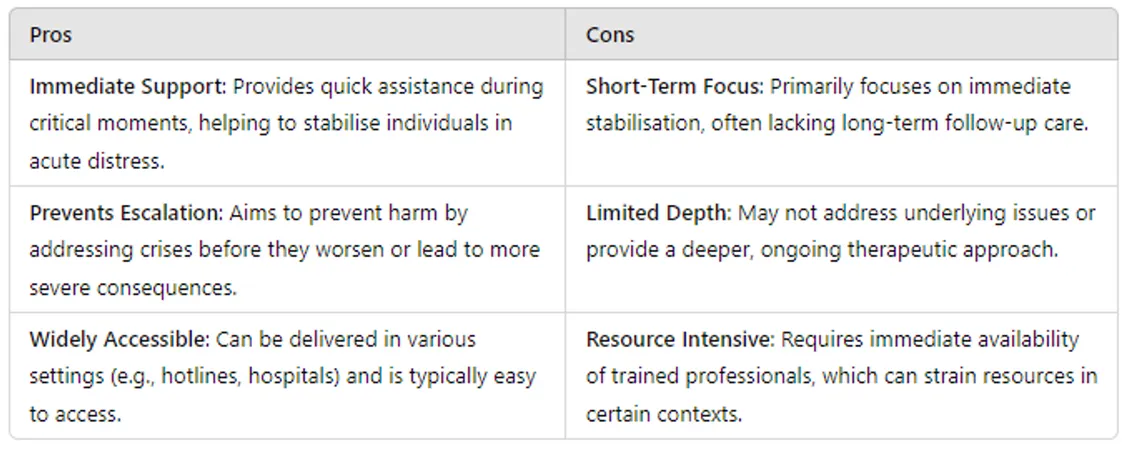
What not to do during an intervention
It’s important to realise there could be negative consequences to a poorly conducted intervention. The person may feel attacked, isolated, or become more opposed to treatment, making the situation worse.
The intervention may be useless if it's not well timed. For example, it's not a good idea to intervene before the person has had their first dose of drugs or alcohol, or right after as they might be more on edge due to needing that drug. The main points to avoid doing when conducting a successful intervention are:
- Forget to provide support – Scott Ardley, senior Treatment Advisor states. “It’s so important that the individual doesn’t feel alone during those vulnerable moments.” It is always important to continue ongoing support after the intervention so that the individual feels like they aren’t alone. According to UK addiction treatment data, about 48% of individuals in treatment for substance misuse return to services for additional support at some point.
- Avoid the blame and judgement – “If you blame the individual more often than not it will push them further away and it’s unlikely they will seek help.” it’s important to express a concern not to make the individual feel judged. For example, not commenting on the fact they may be using an illegal substance and hurting those around them but that they are victims to this addiction and there is help out there.
- Not planning properly – “Planning is key to a successful intervention, there are multiple elements to think about but try to understand it from the individual's point of view.” There’s potential to create more harm than good with an unplanned intervention. For example, the individual could lash out at those around them or leave the intervention and abuse the substance more than before in retaliation.
Get professional support for staging an addiction intervention
Planning an intervention is often a delicate process that may require professional support. In these cases, an experienced interventionist can help. At Rehabs UK, our experienced and fully trained Treatment Advisors can offer support and resources to assist in planning an intervention and recommend an interventionist if necessary.
The most successful interventions are those that combine a good amount of planning with compassion and continue to follow through with the plan with care. There are several different methods and models and with expert guidance, we can help you choose the one most suitable for your specific issues.
If you or a loved one are struggling with addiction don’t hesitate to contact our specialist team today.
